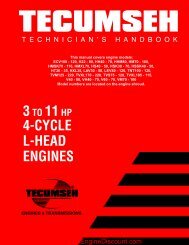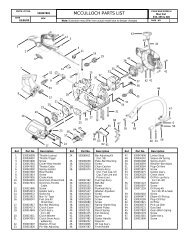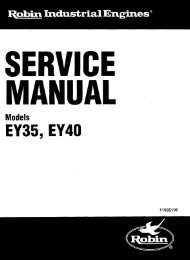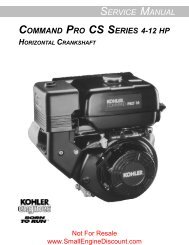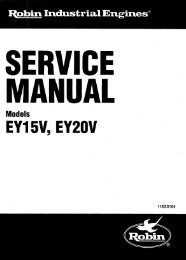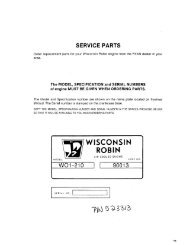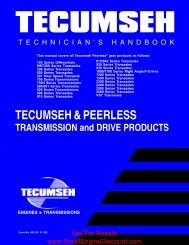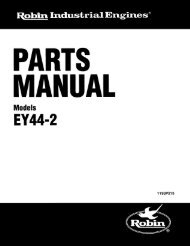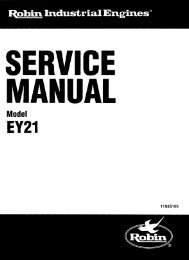4-CYCLE OVERHEAD VALVE ENGINES - Small Engine Discount
4-CYCLE OVERHEAD VALVE ENGINES - Small Engine Discount
4-CYCLE OVERHEAD VALVE ENGINES - Small Engine Discount
Create successful ePaper yourself
Turn your PDF publications into a flip-book with our unique Google optimized e-Paper software.
CHAPTER 9 INTERNAL ENGINE AND CYLINDER<br />
GENERAL INFORMATION<br />
This chapter covers the cylinder block, piston and rod assemblies, cylinder head, crankshaft, camshaft, valve<br />
train, breather, cylinder cover, flywheel, counterbalance systems, and lubrication systems. The governors and<br />
the governor systems are covered in Chapter 4.<br />
All Tecumseh engines covered in this manual are four cycle engines with the valves in the engine head. The<br />
crankshaft position is designated as either horizontal or vertical as the engine rests on its base. The engines<br />
identified by decals or model as XL (Extra Life) or XL/C (Extra Life / Commercial ) are made using aluminum<br />
alloy diecast around a cast iron cylinder liner. However, not all engines with cast iron cylinder liners are identified<br />
as XL or XL/C.<br />
OPERATION<br />
4-<strong>CYCLE</strong> ENGINE THEORY<br />
All 4-cycle engines require four piston strokes or cycles<br />
to complete one power cycle. The flywheel or the<br />
equipment load on the crankshaft provides the inertia<br />
to keep the engine running smoothly between power<br />
strokes.<br />
The engine camshaft gear is twice as large as the<br />
mating gear on the crankshaft to allow proper engine<br />
valve timing for each cycle. The crankshaft makes<br />
two revolutions for every camshaft revolution.<br />
1. INTAKE. The intake valve is open and the<br />
exhaust valve is closed. The piston is traveling<br />
downward creating a low pressure area,<br />
drawing the air-fuel mixture from the<br />
carburetor into the cylinder area above the<br />
piston (diag. 1).<br />
2. COMPRESSION. As the piston reaches<br />
Bottom Dead Center (BDC) the intake valve<br />
closes. The piston then rises, compressing<br />
the air-fuel mixture trapped in the combustion<br />
chamber due to both valves being closed<br />
(diag. 2).<br />
3. POWER. During this piston stroke both valves<br />
remain closed. As the piston reaches the<br />
Before Top Dead Center (BTDC) ignition point,<br />
the spark plug fires, igniting the air-fuel<br />
mixture. In the time it takes to ignite all the<br />
available fuel, the piston has moved to Top<br />
Dead Center (TDC) ready to take the full<br />
combustive force of the fuel for maximum<br />
power during downward piston travel. The<br />
expanding gases force the piston down (diag.<br />
3).<br />
4. EXHAUST. The exhaust valve opens. As the<br />
piston starts to the top of the cylinder, the<br />
exhaust gases are forced out (diag. 4).<br />
After the piston reaches Top Dead Center (TDC), the<br />
four cycle process will begin again as the piston moves<br />
downward and the intake valve opens.<br />
1<br />
2<br />
3<br />
58<br />
Not For Resale<br />
www.<strong>Small</strong><strong>Engine</strong><strong>Discount</strong>.com<br />
4




